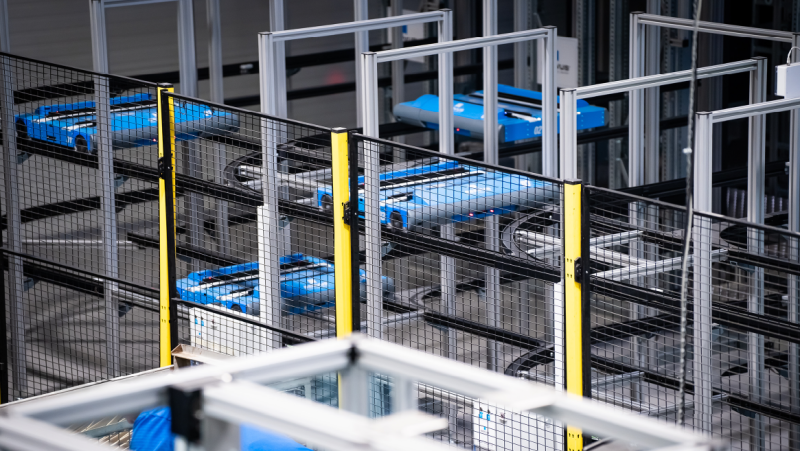The Five Things You Need for Successfully Launching Your Production and Logistics Automation Project
- Automation
- Article
The automation of logistics and manufacturing is steaming ahead. This trend has been helped along by the constant pressure for efficiency, along with the digital transformation and a shift towards greater freedom from human capital. All this has made way for the deployment of new technologies, with which automation is often connected. How can you maximise logistics automation’s potential while making sure your project goes as smoothly as possible?
1. An enthusiastic leader who holds a specific vision – and personal responsibility
Often the leading personality in automation projects doesn’t have to be a company’s owner or CEO. Taking their place is a person who knows all the processes in detail, has the team’s trust and has room to explain and then implement their vision – a logistics manager. Sometimes an owner or CEO may take their place, but something will always be missing – this primarily tends to be expertise and time.
RISK: What if I don’t have an enthusiastic leader for my automation project?
What is the most common Achilles’ heel of automation projects? A long-term vision for the ideal state of logistics. Without it, a project will often jam up quite early and never see execution. If the project leader does not know what they actually want, they’ll be unable to formulate requirements for suppliers’ proposals either. This can slow the entire process, even by years. Also, due to the confused task description, not even the smartest supplier can help. The firm will receive bids that are overpriced or address a different problem than the one they really have. What’s the solution? Seek advice and education. Reference visits to plants where a similar system is already running are a great help here.
What is the most common Achilles’ heel of automation projects? A long-term vision for the ideal state of logistics. Without it, a project will often jam up quite early.
2. A strong internal team you can rely on
You might think: “Is the team really so critical? After all, we have a capable manager with a clear vision!” Although your leader does have a vision of what, how and why, without an experienced team they still can’t shape it into functional steps that are a good fit for the individual roles and logistics functions. It often happens that a project will be shelved due to uncertainties in its internal team. You’ll even find cases where the dynamics of the preparation team lead to shakeups in the management. After all, trust is utterly essential.
RISK: What if I just don’t have a strong internal team?
One leading personality can handle the project kickoff, but such individuals will soon run out of steam. Although it may seem like cooperation with people from various specialisations will slow the project down, it radically increases both the solution’s chance of success and its sustainability! Don’t be afraid to engage further experts; you won’t regret it.
Would you rather be reading the specific stories of companies where automation project is already running? Take a look at their case studies!
3. An experienced technology partner who explains both the pros and cons
Don’t leave yourself unsupported! We have never experienced a single project that made it all the way to execution without partners. How can that be? A technology partner will avert quite a few catastrophes. They offer experience with dozens to hundreds of projects, explain it all to you through specific examples, and if things don’t go according to plan, they’ll suggest which way to turn. Furthermore, a technology pro will only present truly implementable proposals. They will point out the boundaries, preserve your requirements and exclude anything that might be too expensive or risky.
Solutions tend to be compromises, and you need to work with not only the vision for your logistics, but also the possibilities of different technologies, the extent of automation, the price and the gradual shaping of a plan. Honestly, you don’t want to go it alone!
RISK: What if I can’t find a strong technology partner?
If you don’t take partner selection seriously, your automation project can become significantly more expensive, and it will often even go unimplemented. Every change or shift to a different advisor brings with it sunk costs, as well as a transformation of the project itself. That’s why it makes sense to invest time into your choice and seek out partners whom you can trust and with whom you can share the above-mentioned vision. Don’t be afraid to ask questions. To verify whether a potential technical partner will be able to explain their stances and recommendations. And above all, that their foremost wish is to provide a solution to your problem.
4. Company-wide support that paves your way
Like it or not, an automation project will affect your whole company. Its opponents can cause delays or even stop the whole project. So during the preparation phase, don’t forget to engage key users – not just from logistics, but also from IT, QC and production, and often the workshop as well. If at this point you already manage to kick off an open discussion on your project’s ideal outcome for all parties, you’re halfway there.
When selecting your partners, keep in mind that process standardisation awaits you: choose colleagues who are patient and like to seek compromises that suit everyone. That will be very useful on your journey as well.
RISK: What if I want to just stick to the basic team, and not include other colleagues?
The outcome of your automation project has to work across the board. If you leave out one area or another, its workings can become significantly more complicated and end up worsening the situation. Additionally there’s the threat of resistance towards the new solution, which can slow the project, stop it, or cause the solution to simply lie unused after the project’s completion. Because you’re providing something your employees don’t want, and they don’t understand how the change will help them.
5. A flexible systems integrator who leaves room for growth
Why do you need an integrator when you have a cross-company team set up and a technology partner at your back? In the preparations phase, it may still seem you can make do without the integrator role. But the further you get into planning, the more you need to be secure that you’re building a robust and effective solution. The foundation of automation is the integrating of a variety of technologies and systems. A systems integrator will also ensure solutions for irregular states, they’ll know the scenarios you can encounter, and they’ll ensure that you’re truly approaching your defined goal. That’s why it’s fundamental to emphasise flexibility. To ask for evidence, and to make use of reference visits to solutions that resemble yours and are already running. Seek a partner, not just a supplier. A good systems integrator will account for the chance that your assignment and your conditions might change in mid-project – that you may want to involve entirely new technology in a few years. After all, that’s an everyday part of automation projects!
RISK: What if I choose a poor systems integrator?
It is very likely that your project will still launch even with a rather inexperienced systems integrator. But similarly as with a low-quality building, you may soon encounter unexpected problems. These may be limitations in the resulting solution, missing links, or an inability to move ahead, to innovate. Once you run into complications like these, it’s extremely complicated to change your path’s direction. Completely exchanging your solution or integrator is very expensive, and additionally, your company has just been through the entire system-building process. Just like during the construction of a house, a systems integrator is a partner for at least a decade. The solution must take precedence over the technology. That’s another reason why it’s critical to have a long-term vision.
Not sure how to integrate a variety of technologies and systems? Take advantage of a non-binding consultation with an Aimtec expert!
For projects that automate logistics and manufacturing, it pays to develop long-term partnerships. In the project itself, with your internal team, with your technology partner and with your systems integrator. These are precisely the people who will stand at your side as you realise your vision over the next several years.
Share article
Top stories from logistics, production and IT.
Subscribe to Aimtec Insights
By registering, you agree to the processing of your personal data by Aimtec as described in the Privacy policy.
Get top stories and articles
from Logistics, Production and IT.
Subscribe to Aimtec Insights
By registering, you agree to the processing of your personal data by Aimtec as described in the Privacy policy.








